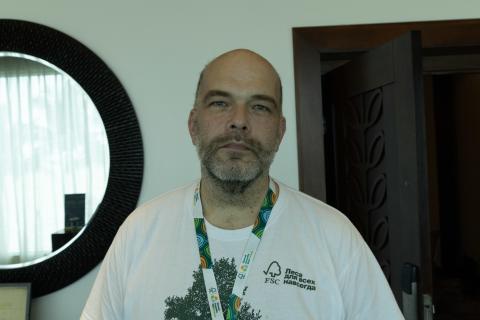Rebooting FSC: a fresh perspective
After 20 years of reconciling interests, FSC is showing signs of fatigue. But surely the system will receive a vitalising injection of innovative thinking from its members this week. Before we leap into the future, let’s step back, take a deep breath and overlook the battle plains.
FSC General Assembly 2014
Editorial by Peter Feilberg, Executive Director, NEPCon & Richard Donovan, Senior Vice President of Forestry, the Rainforest Alliance
On the cusp of the 7th FSC General Assembly, let’s take a look at the big picture and the context in which FSC operates.
FSC is without doubt amongst the most successful certification schemes for sustainable land use and a beacon for many other schemes. As a pioneer scheme, it has demonstrated the feasibility of a solution that many considered impossible 20 years ago. Based on its signature model for global democracy, FSC has developed tremendously with broad buy-in from its stakeholders.
Today, forest land covering over 180 million hectares is FSC- certified, and the number of FSC certificates worldwide is nearing 30,000. The FSC label is visible in markets all across the world.
Is FSC running out of steam?
However, recent years have seen the expansion of the FSC scheme slowing down. In some countries, such as the US, the number of certified operations has even decreased. This is doubtlessly linked to some tenacious challenges that FSC has struggled to find solutions for.
Access for smallholders
Getting the small-scale and the disadvantaged on board is a continuing challenge and a rising priority that simply needs to be dealt with. FSC certification is too complex and costly for most small-scale forest operations and in practice only open to those who can afford it. The resulting social imbalance is a problem in itself. In addition, it implies a significant loss of impact, since smallholders own a sizeable part of the world’s forests.
There has hardly been a general assembly without motions requesting that FSC change this imbalance. Numerous solutions have been tried and tested for years ¬¬– including group certification, reduced requirements for the small (SLIMF), and various support programmes – however, none of these has solved the basic problem. Small modifications to the current system are clearly not enough. New approaches are called for.
These might entail: a) focusing only on aspects that really matter in terms of the desired outcome, i.e. what happens in the forest; b) removing superfluous requirements for procedures and paperwork; c) using a risk- based approach to compliance evaluation; d) developing alternatives to property-level certification; and e) finding ways for smallholders to benefit from certification.
Reduction of system bureaucracy
Standards, directives, advice notes, policies: years of incorporating countless motions have led to a growing volume of FSC requirements and a self-perpetuating bureaucracy. This has escalated to a level where resources are now being overspent on paper shuffling. FSC’s elaborate trademark rules and zealous procedures for overseeing trademark compliance are prime examples.
Ultimately FSC wants to avoid making the system less amenable to business without walking away from what makes the system valuable; that is a strong focus on improvements in forestry practice.
It is both the speed and volume of change that is putting certificate holders’ trust in the FSC as a dependable system at risk. A certified company practically never knows when the next announcement of system changes will appear in their inbox, sometimes with very short deadlines for compliance.
Resources saved on reduced paperwork can be re-invested in a stronger focus on field performance. There are several ways of simplifying the FSC system without harming its integrity. Removing superfluous requirements and taking a risk-based approach to compliance evaluation are some of the obvious steps.
So are improving communication between FSC and certificate holders about when and why changes are being introduced with a focus on how those changes add value to the system integrity and not just burden to the business implementing the requirements.
Reinforcement of stakeholder trust
One of the biggest strengths of FSC is its broad support, which is fully in evidence at general assemblies. The endorsement from leading NGOs) gives FSC its air of credibility and robustness. However, NGOs that have for years worked to strengthen FSC’s integrity and impact on the ground are becoming impatient to see faster progress. They are stepping up public criticism, and some FSC certificate holders are finding themselves in the firing lines.
Ensuring system credibility and high performance remains a key priority for satisfying critical NGOs and ultimately for all other FSC stakeholders as well. Ultimately, changes to enhance the FSC system must not throw the baby out with the bath water by sacrificing its ability to secure good forest management in practice.
FSC’s impact on the ground could be strengthened by replacing the current ISO approaches with a new, risk-based approach to auditing. This could significantly reduce the cost/impact ratio of FSC certification, making better use of the system’s limited resources. In addition, competence building, better guidance for auditors and certificate holders, and innovative technical solutions could help to boost FSC’s impact.
Forest conversion
Another long-standing issue is the exclusion of post-1994 converted forest land from certification. The problem is that current policies do not take local complexities into account. In many cases, the rule is causing social injustice and in some regions it significantly impairs FSC’s ability to halt deforestation and promote forest conservation. This is especially pronounced in the tropics where the scheme has the highest potential for making a difference.
It is important to halt further conversion of natural forest into plantations or other land use. However, to avoid adverse effects it is necessary to take stock of the reality in those countries where the rule comes into play, and perhaps allow some flexibility in the national forest standards. For example, exemptions from current rules might be granted based on certain conditions, or perhaps new solutions that foster social and environmental values can be created.
Reshaping FSC to meet the future
Whilst FSC is battling all these and other challenges, PEFC – the other major international forestry certification scheme – may be gaining ground. For example, FSC is struggling to remain relevant in Asia, which is the fastest growing market in the world.
Right now, FSC appears to be in a fix, stuck between conflicting demands, with its stakeholders exhausted from years of arguing the same points over and over again.
It’s time to re-think the FSC system and come up with robust solutions enabling FSC to realie its full potential for positive impact. For FSC to get back into the express lane, it needs to remove the major stumbling blocks on the road ahead and continue to set the golden standard for responsible forestry assurance.
 | Peter Feilberg Executive Director NEPCon |  | Richard Donovan Senior Vice President of Forestry The Rainforest Alliance |
This article was also published at the FSC website.



